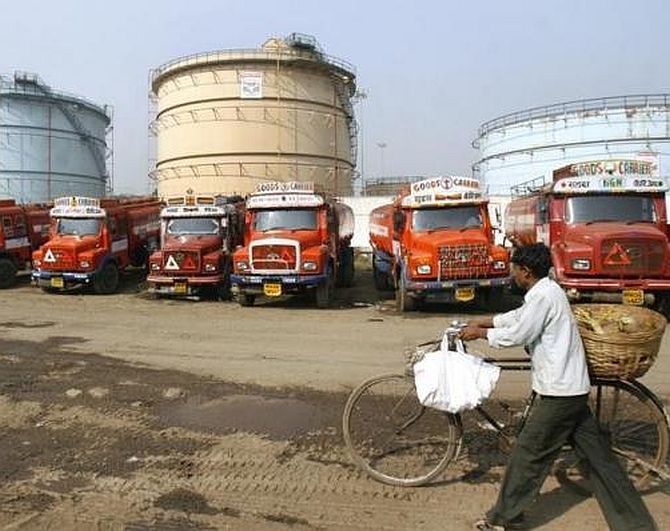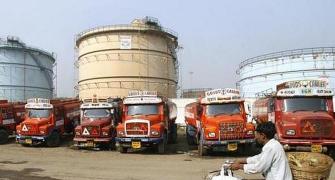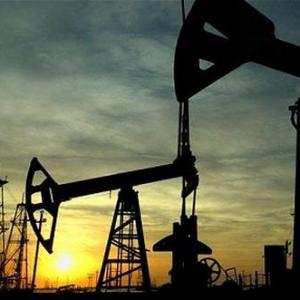Lower oil prices have boosted growth by more than one percentage point; but that may soon go away, says Sajjid Z Shenoy.

In all the discussion about India's growth performance and prospects, the elephant in the room is barely discussed.
Growth sceptics worry about a sluggish global economy and a struggling rural economy.
Growth optimists point to the government's reform efforts and the impact these will eventually have on the ground.
What's surprising about this debate, however, is that nary a word is said about the most significant driver of growth in India over the last year: a massive, positive terms-of-trade shock in the form of lower oil prices that has boosted activity.
Let me elaborate. India is a very large commodity importer, in general, and oil, in particular.
So when oil prices collapse from $110 to $45, economic agents in India experience a large income windfall: resources that should have been transferred to the outside world are now retained by households, corporates and the government.
To the extent that some of this income is consumed or invested rather than saved, it translates into higher economic activity and growth.
So what was the quantum of the terms-of-trade shock and the growth impact?
To whom did it accrue to? And what does this mean for growth prospects, given this is a one-time bonanza that will soon roll off?
This piece tries to make sense of these unanswered questions. In the four quarters preceding October 2014, India's net oil imports averaged 5.3 per cent of gross domestic product (GDP).
Over the last four quarters, on the back of the collapse in oil prices, the net oil import bills have collapsed to 3.2 per cent of GDP.
In other words, the positive terms-of-trade shock that India has experienced is about 2.1 per cent of GDP.
That's huge. It's easily the largest positive terms-of-trade shock that any emerging market experienced over the last year.
We estimate that almost half the windfall (0.9 per cent of GDP) accrued to the government in the form of a much lower oil subsidy bill and higher oil taxes, with excise duties on petrol and diesel being almost doubled and tripled respectively.
While the Centre benefitted by one per cent of GDP, states - they levy an ad valorem tax on petroleum products - are estimated to have lost about 0.1 per cent of GDP.
All told, the consolidated government received a windfall of 0.9 per cent of GDP that was entirely spent. How do we know that?
Before oil prices fell, the central government's fiscal target was 4.1 per cent of GDP for FY15 and 3.6 per cent for FY16.
If the entire windfall had been saved across two years, the FY16 target should have been 2.6 per cent of GDP. Instead, this year's out-turn is expected to be 3.9 per cent of GDP.
This is not meant to critique the government's strategy. Over the last year, the government has correctly tried to boost public investment, even as it was simultaneously deprived of the 'inflation tax'.
So appropriating and spending some of the oil gains made sense, though it makes this year's fiscal task much harder, when the government will not have access to incremental oil gains, and is faced with a much larger consolidation and a Pay Commission report.
The rest of the oil surplus - 1.2 per cent of GDP - was distributed among households and firms.
Households benefitted from lower fuel prices which boosted purchasing power, while firms benefitted from a collapse in raw material costs which boosted margins.
The first round impact on households was low - only about 0.2 per cent of GDP - given the low weight of fuel products in the Consumer Price Index, retail fuel prices not mirroring global price dynamics because of the tax hikes and many fuel products with administered prices.
Interestingly, however, the cumulative benefit to households extended much beyond lower fuel prices, because firms passed on a chunk of their benefits to households to stimulate flagging demand and retain market share. How do we know this? Take the BSE 200 for example.
Over the last year, raw material costs to sales have fallen by nearly 700 basis points, but EBITDA margins have only increased by 290 basis points, suggesting that firms passed on 60 per cent of their input cost benefit in the form of lower final goods prices.
This ties in with a host of anecdotal evidence of price cuts/temporary discounts/offers at the dealer level.
All told, therefore, we estimate that the cumulative benefit to households was about 0.8 per cent of GDP, while firms only retained about 0.4 per cent of GDP, in the wake of weak demand conditions.
Most studies find that households' marginal propensity to consume in India is about 0.7, so households are expected to have spent about 0.5 per cent of GDP - which ties in with strong urban consumption over the last year.
In turn, we believe most of the firm windfall has been saved, consistent with weak investment. What does all this mean?
That, of the 2.1 per cent of GDP terms-of-trade windfall, about 1.3 per cent of GDP was spent, thereby boosting growth by that amount over the last four quarters, spread across two fiscal years.
Over that time, India's GDP growth averaged 7.4 per cent.
What this suggests is that after netting out the oil impact, underlying growth may have been closer to six per cent, reflecting the export slowdown and rural stress. Why does this matter? Because this is a one-time 'growth' windfall.
If oil prices stabilise at these levels, there will be no incremental 'growth' impact through progressively higher purchasing power or corporate margins.
And government capex spending growth will need to be supported by cuts elsewhere or new revenue measures.
There won't be a free lunch, like there was last year. This is not meant to be alarmist.
To its credit, the government has made a renewed push at reforms over the last month.
But the uncomfortable reality is that growth has benefitted significantly - over a percentage point -because of the collapse in oil prices.
That will soon go away, if prices stabilise. And other drivers of growth will need to quickly step up, if a slowdown is to be avoided.
Sajjid Z Shenoy is chief India economist, J P Morgan










